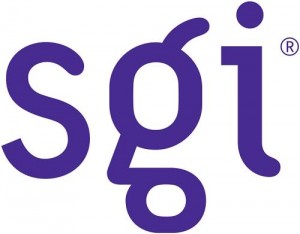When talking about supercomputers the first names that come to mind are Cray, IBM, SGI, etc. Those are some of the most influential companies in the history and evolution of supercomputing. A list of the most important companies, their achievements, and systems are described in table below.
| |
 | Cray is one of the most renowed supercompuer companies in the world, also known for becoming pioneer in such area with the release of their Cray-1 supercomputer in 1976[1, 2]. If we take a look at the latest supercomputer rankings we can find up to 3 Cray systems in the top 10: Jaguar, Cielo and Hopper. All of them holding a computing power above 1 PetaFLOP.
The third most powerful supercomputer has been produced by Cray, and is located in the National Oak Ridge Lavoratory in USA: The Cray XT5 Jaguar. The Jaguar is powered by 224.256 AMD Opteron cores, wich means a computing capability of 1.75 PetaFLOPs. Such amount of power is distributed among 18.688 nodes, each node featuring two Hex-core AMD Opteron-2435 processors and 16GB of RAM.[3, 4, 5] |
 | IBM is also one of the most reowned supercomputing companies in computer history. They became pioneers during the 60's when they delivered the IBM 7030 in 7961. This computer had a computing capability of 4MIPS. During the 90's IBM built a chess supercomputer named Deep Blue. This machine was able to beat Kasparov, the chess world champion by then. Deep Blue was conformed by 30 RS/6000 nodes, each one holding 30 P2SC microprocessors running at 120MHz. The whole system had a total computing power of 11.38 GFLOPS and was able to execute 200 million chess movements per second. Later, IBM produced a improved version: The Deeper Blue, that was able to beat Kasparov in a 6 game encounter. In 1999 IBM founded the Blue Gene
project. Such project was oriented to the desing of PetaFLOP capability supercomputers, but consuming limited amounts of power. The most important machines produced during the lifetime of this project were the Blue Gene/L, the Blue Gene/P an the Blue Gene/Q. All of these computers dominated the supercomputing rankings for many years. Te fastest IBM supercomputer nowadays is the RoadRunner. It holds the world's 10th place with a peak performance of 1.7 PetaFLOPS. The RoadRunner is a Hybrid design consisting of 12960 PowerXcell 8i -similar to PS3's cell CPU- and 6480 dual-core opteron processors. The total amount of RAM is 103.6TB [4, 5, 6, 7, 8]. |
 | NEC has been a consistent supercomputer designer and manufacturer since they developed the SX-1 and SX-2 systems in 1983. Between 2002 and 2004, NEC held the record of having the fastest supercomputer on the planet: The Earth simulator. This computer consisted of 2400 nodes with intel Xeon CPUs and NVIDIA Tesla processors. According to the latest ranking, the earth simulator is the fifth fastest supercomputer in the world with a computing power of 1.192 PetaFLOPS.[4,9] |
 | One of the most remarkable supercomputers built by Fujitsu was the Wind Tunnel Simulator (WTS). It was developed in conjunction with the Japan Aerospace Laboratory and held the record of being the most powerful supercomputer between 1993 and 1996 with a sustained performance near 100GFLOPS[11]. The WTS had 166 vector processors, each one with a peak performance of 1.7GFLOPS. Fujitsu is the developer and builder of the fastest supercomputer in the world: The K computer, which is located in RIKEN Advanced Institute for Computational Science in Japan. It has a total of 705124 cores distributed among 80.000 nodes. Each node has an 8-core SPARC64 VIIIfx processor and 16GB of RAM.[10] |
 | Silicon Graphics Inc. is another well-known manufacturers of high-performance workstations and supercomputers, especially in the entrertainment/movie industry. In 1999 the company ventured into the supercomputing industry by acquiring Cray for a brief period of time [12]. In 2004 SGI built the record breaking Columbia supercomputer, located in the NASA AMES research center. This machine consisted of a cluster of 20 Altix supercomputers, each one with 512 Intel Itanium 2 processors. The computing power of the whole system was 42.7 TeraFLOPS. In 2011 Fujitsu delivered Pleiades, a super computer developed in conjunction with NASA AMES research center. This machine reached a peak performance of 970 TeraFLOPS becoming the seventh fastest computer in the world. Pleiades was built using Altix ICE nodes and the whole system holds a total of 111104 Intel Xeon processors. It is expected that by performing hardware updates, this computer will be able to reach the 10 PetaFLOPS mark.[13] |
REFERENCES
[1]
http://www.cray.com
[2]
http://es.wikipedia.org/wiki/Cray-1
[3]
http://es.wikipedia.org/wiki/Cray_XT-5
[4]
http://www.top500.org/
[5]
http://es.wikipedia.org/wiki/Cray_Inc.
[6]
http://www-03.ibm.com/systems/technicalcomputing/
[7]
http://en.wikipedia.org/wiki/IBM#Research_and_inventions
[8]
http://en.wikipedia.org/wiki/Category:IBM_supercomputers
[9]
http://en.wikipedia.org/wiki/NEC_SX_architecture
[10]
http://www.fujitsu.com/global/about/tech/k/
[11]
http://en.wikipedia.org/wiki/Numerical_Wind_Tunnel
[12]
http://en.wikipedia.org/wiki/Silicon_Graphics
[13]
http://www.nas.nasa.gov/hecc/resources/pleiades.html




0 comments:
Speak up your mind
Tell us what you're thinking... !